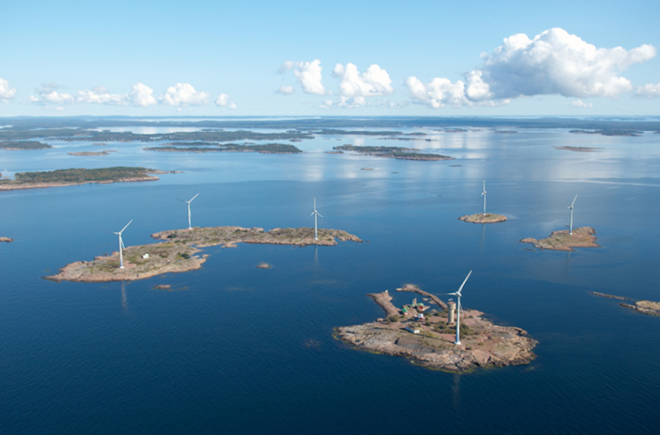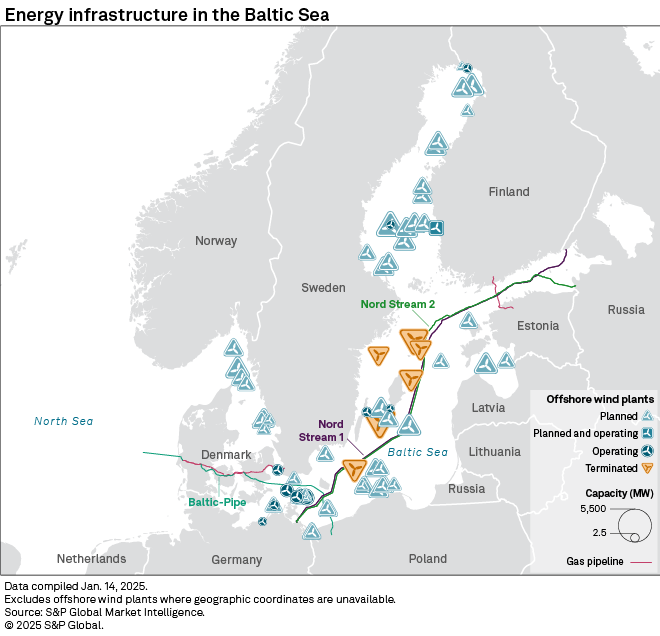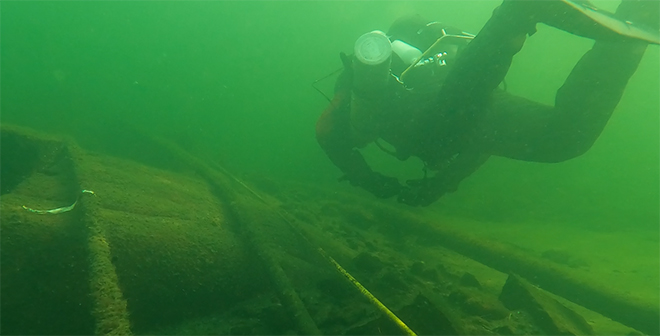S&P Global Offerings
Featured Topics
Featured Products
Events
S&P Global Offerings
Featured Topics
Featured Products
Events
S&P Global Offerings
Featured Topics
Featured Products
Events
Banking & Capital Markets
Economy & Finance
Energy Transition & Sustainability
Technology & Innovation
Podcasts & Newsletters
Banking & Capital Markets
Economy & Finance
Energy Transition & Sustainability
Technology & Innovation
Podcasts & Newsletters
S&P Global Offerings
Featured Topics
Featured Products
Events
29 Jan, 2025

By Camilla Naschert

|
The Lilla Båtskär wind farm in Åland near Finland, where developer OX2 has tested a multi-pronged monitoring system. |
Amid rising military risk in the Baltic Sea, offshore wind developers in the region say they can leverage their assets to monitor against threats. This comes as some lawmakers see offshore wind as incompatible with defense objectives in the region.
A series of suspected sabotage incidents in the Baltic Sea, which European Union countries share with Russia, have focused minds on the risks involving energy infrastructure assets.
Defense alliance NATO recently reinforced its presence in the Baltic Sea, reacting to a string of incidents in which cables or pipelines were damaged.
In November 2024, the Swedish government rejected planning applications for 13 offshore wind projects in its waters, citing a security risk because the turbines could delay the detection of potential incoming missiles in the event of war.
"The government has made the assessment that building the current projects would lead to unacceptable consequences for Sweden's military defense," Swedish Defense Minister Pål Jonson said at the time. "In the serious security situation Sweden is currently in with war in our immediate area, defense interests must weigh very heavily when such judgments are made."

'Virtual fence'
Despite the infrastructure risk, the region's offshore wind potential is still being pursued.
While Sweden is reining in development in its share of the Baltic Sea, neighboring countries such as Finland, Estonia, Poland and Lithuania are pushing ahead with new project approvals and construction.
Infrastructure risks can be tackled through heightened surveillance, according to developer OX2 AB, which has tested various monitoring techniques.
EQT AB-owned OX2 has obtained approval from Finland's defense forces to build the 5-GW Noatun Nord offshore wind farm at a site north of Åland, a group of islands in the Baltic Sea between Sweden and Finland.
A second 4.7-GW project, Noatun Syd, located south of Åland, is awaiting approval, according to Anders Wiklund, head of OX2's Åland business.
To protect the multibillion-euro investments in such projects, "we want to be on top of situational awareness," the executive said.
The company has tested technical solutions at its existing Lilla Båtskär wind farm in Åland, including air surveillance, underwater radar, cameras, hydrophones and sonar equipment. The demonstrations created what Wiklund described as a "virtual fence" around the asset.
"We then simulated 200 different scenarios to see if we can spot the threat," Wiklund said. This included attacks via airplanes, jet skis, divers and anchors dragging.
"The security concept works very well," Wiklund said, noting that all simulated threats were detected in various weather conditions.

|
A diver taking part in a security test in Åland. |
'All in the same boat'
More than 250 participants from public authorities and defense forces of 10 countries attended information sessions about the monitoring concept, according to Wiklund. Representatives from competing developers were also present.
"We are all in the same boat. There is actually no real conflict because we all want the same thing. We need to build energy and protect this critical infrastructure," Wiklund said. Investments in monitoring could also be welcomed by insurance companies, the executive added.
The concept proposed by OX2 is designed to counter attacks of a hybrid war nature, Wiklund said. That includes sabotage, illegal surveillance or hacking efforts — but not full-blown war.
"Those that have bad intentions will get caught red-handed," Wiklund said.
Partners in the project include Danish surveillance and military manufacturer Terma A/S, which is also cooperating with Danish wind developer Ørsted A/S on similar projects.
"Energy policy has become security policy," Terma CEO Henriette Hallberg Thygesen said during a Jan. 16 workshop on offshore wind power development and military needs in the Baltic Sea. "The growth of offshore wind in the Baltic Sea mirrors the region's geopolitical importance, demanding cooperation across borders, industries and governments to ensure a resilient and secure future."
Turbines as assets
Another group working on defense-adjacent technology for surveillance is the startup Elevated Launch, founded by a group of scientists at the Research Institute of Sweden in Gothenburg.
The group has received patents for drone parking solutions, which include parking atop a wind turbine and even underwater.
"This makes it possible to use the turbine as a base," said Anders Engström, one of the engineers behind Elevated Launch. "They can be an asset rather than only a problem."
Elevated Launch is running demonstrations of its concept in the Baltic Sea, in coordination with the Swedish military.
"We want to become an integrator working to enable approval of wind projects," Engström said.
In Sweden, the road to implementation of such projects seems long, with legal and technical challenges still unresolved.
The Swedish military said it is following the technology development in this field and is looking forward to studying the conclusions of the Elevated Launch project. However, it is too early to speculate on the results or the significance for the military, according to Henrik Nyström, the Swedish military's press secretary.
"When it comes to offshore wind and the integration of military systems, there is currently no legal basis for integrating those solutions within civilian infrastructure," Nyström said in an email.
"At present, we have also not seen any technical solutions that deal with the risks we have identified with offshore wind power linked to interference with our sensors, radar systems and our signal intelligence."
